
 Comparison Tests
Comparison Tests
If their mutual ruddiness is not a firm enough basis for a comparison test between a 24-year-old, mid-engined, flat-12 Ferrari supercar and America’s favorite son, then consider that virtually everyone in the greater Los Angeles area mistook our Torch Red Corvette Stingray for a Ferrari. Sure, it’s possible that no one currently living in the L.A. basin has ever seen a Chevrolet passenger car, but still.
Also, a nice 1990 Ferrari Testarossa—perhaps not quite as nice as our original-owner example, but decent—can be had for about $62,000, within striking distance of this $65,480 Stingray coupe equipped with the Z51 Performance package. And look, it’s been a dream of mine since my pimple-faced, MG Midget–driving teen years to get just a taste of this quintessential ’80s supercar. It was the car that I imagined Wall Street types would drive from hostile takeover deals to orgies with the women from Patrick Nagel illustrations. Detestable yuppies they might have been, but man, their hair was feathered so much more luxuriantly than my own. So please, let me have this moment.
Let’s be clear: The Corvette is the better all-around car. No question. It’s quicker, more comfortable, more fuel efficient, and in every way easier to drive than the Ferrari. The Vette’s traction and stability-control systems allow you to use more of its potential more of the time with more confidence. The Testarossa has only the calming influence of its apparently very stable and respectable owner in the right seat to remind you to keep your head about you. The Corvette’s power-assisted controls don’t require of its operator a fat left calf or any upper-body strength whatsoever. The Corvette’s seven-speed shifter selects gears with precision. And, should it please you, the car will blip the throttle to smooth your downshifts, making you look like a hero. The Ferrari’s heavy, recalcitrant gated shifter is at all times actively trying to make a fool of you.
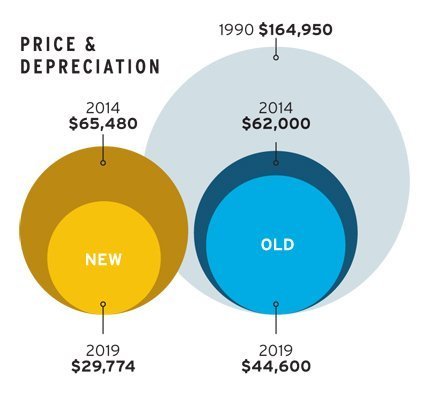
 In the Stingray, every modern convenience is yours. Somewhere along the way, brakes became a critical part of automotive styling.
In the Stingray, every modern convenience is yours. Somewhere along the way, brakes became a critical part of automotive styling.
The Corvette’s nav system will display your next turn—in three places, including projected directly into your line of sight. And if that’s not enough, there’s an exceptionally pleasant woman who lives in the dashboard and will tell you where to go, too. The Testarossa has only a curiously large vanity mirror in the glove box. Because cocaine.
When introduced as a 1986 model (with sweet center-lock, flat-spoke wheels and a crazy high-mounted single side mirror), the 380-hp Testarossa was the fastest car available, with a top speed of nearly 180 mph. The new Cadillac sedan that sits outside my office window makes 420 horsepower from a turbocharged V-6. The Cadillac also gets to 60 mph more than half-a-second quicker than the Ferrari (4.4 seconds versus 5.0). The Corvette Stingray is about a further half-second quicker than that. On paper, this fight is over before it begins. And that’s without considering that a replacement gas cap for the Testarossa can cost $800 and that you’ll need highly paid Ferrari experts to periodically drop the engine of your exotic to replace the timing belts, which will cost about as much as a decent used car. The Corvette has a warranty.
But once you poke your butt across the wide side sill and tuck your feet into the tight pedal box to the right of the huge front wheel-well bulge, you will know that your full-time job in the Testarossa is to drive. There will be no texting, no phone calls. The only aspect of monkey business in which you will engage is stretching out your arms to reach the nonadjustable steering wheel, while your head sinks into your shoulders to avoid the low roof. Trundling around at low speed requires an inordinate amount of shoulder strength. That the Testarossa was considered the first everyday-comfortable Ferrari sports car speaks to how terrible it must have been to drive earlier exotics. By modern standards, wherein supercars are as docile as catnip-loaded kittens, the Ferrari is an anachronism. By the time we finished a spirited run down twisty Little Tujunga Canyon Road near L.A., the backs of our shirts were plastered to the soft tan leather of the seats, my arms were sore, and we were spent. The owner, a heart surgeon, said only, “Well, that got my blood pumping.”
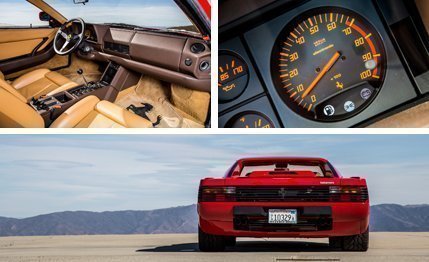

It’s a miracle of automotive development that the same run at the same speed in the Stingray is a nonevent. The Corvette’s otherwise excellent steering feels light and laser-quick compared with the Ferrari’s unassisted helm, which jabbers constantly about the state of affairs on the ground. The Testarossa’s 3.4 turns lock-to-lock (compared with the Stingray’s 2.5) mean you’re shuffling the wheel between your sweaty hands, winding and unwinding, as you guide the Ferrari’s absurdly wide rear end through curves.
Without direct injection or cam phasing, the Testarossa’s engine also requires attention. The artificially fat torque curves of modern performance engines threaten to make lazy drivers of us all. Even with 4.9 liters of displacement, the Ferrari needs some revs to deliver on its supercar promise. But, like the steering, the Testarossa’s engine rewards effort. And no, there is no piped-in engine noise designed by sound engineers. You hear the clatter layered over this exhaust note. You hear the radiator fans working. You hear a large machine at work.
We have no interest in giving back the 20-odd years of development that have resulted in more reliable, more powerful, more fuel-efficient, and safer cars. But those advancements have added layers of isolation to the experience of driving. We are willing to accept that trade-off in our commuting car. But for a weekend car we want the full, unadulterated experience. It’s the difference between an original painting and a lithograph. We will take the Testarossa every time. Well, except for trips to Costco. Then we’ll take the Vette.


GM’s Gen-V small-block has aluminum construction, direct fuel injection, variable cam timing, cylinder shutdown, and an optional dry-sump-lubrication system. A Stingray running this V-8 beats the Testarossa’s top speed by at least 10 mph.
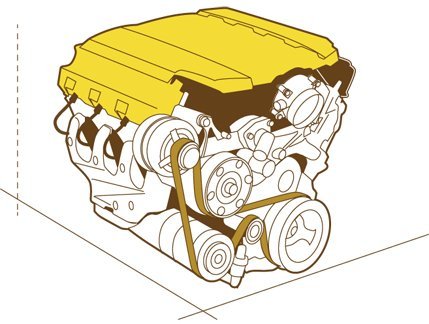

In its day, the Testarossa was the world’s fastest production car. This 4.9-liter flat-12 produced 380 horsepower, 20 more than the 24-valve engine that preceded it in the Berlinetta Boxer.
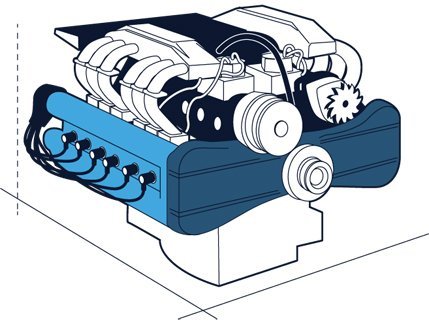

While depreciation can put once out-of-reach vehicles on your reality-based shopping list, remember that running costs are reliable crushers of automotive fantasy. To wit:
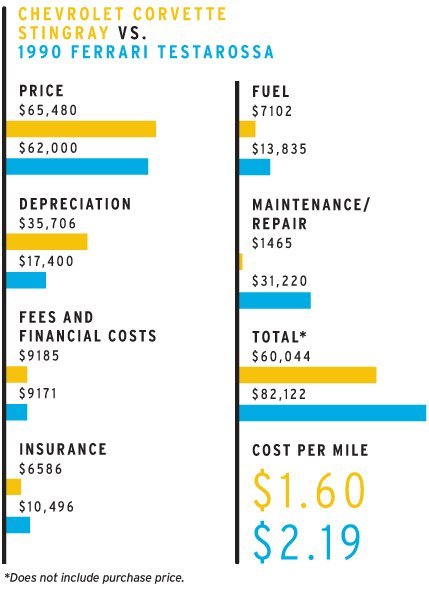
 Cost-of-ownership estimates provided by Vincentric, based on 7500 annual miles for sports cars and 12,000 for others. Residual values from Black Book. Some Ferrari Testarossa data provided by Steve Ahlgrim, Hagerty, San Francisco Motorsports, and Mike Sheehan.
Cost-of-ownership estimates provided by Vincentric, based on 7500 annual miles for sports cars and 12,000 for others. Residual values from Black Book. Some Ferrari Testarossa data provided by Steve Ahlgrim, Hagerty, San Francisco Motorsports, and Mike Sheehan.





